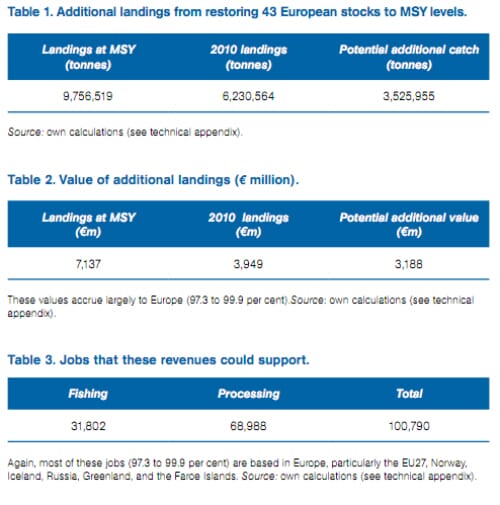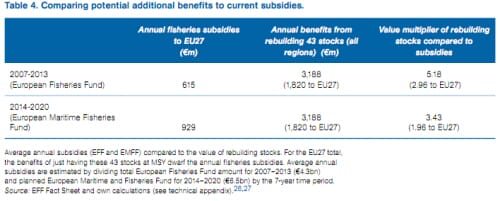The problem
Overfishing is said to occur when fish are captured at a faster rate than they reproduce. This phenomenon has plagued European waters for decades, but has only recently come under public scrutiny. The enormously wasteful practice of discarding fish, throwing away up to 20 to 98 per cent of catch in European fisheries, has sparked public outrage. Yet this is but one part of a worrying trend in the marine world. Some fish stocks have been fished to the brink of collapse.
Some catches are but a shadow of their former selves. The decline in catches has been mirrored by corresponding falls in fishing revenues and, in some countries, the numbers of jobs they support. But for many, struggling in the midst of a global economic crisis, this catastrophe is both out of sight and out of mind. Yet, it is precisely in times such as these that natural resources should be better managed to produce more revenue and jobs.
In this paper, we study 43 fish stocks in European and neighbouring waters and look at how healthy fisheries could sustainably provide more catches and what this means in terms of additional revenue and jobs. We find that over €3 billion is lost every year due to overfishing these stocks. This could support 100,000 jobs in the industry and inject money into a bleeding economy. Isn’t it time we rebuilt our fish stocks?
What it means
Overfishing is the single greatest destructive force in the marine environment. It has made the fishing industry economically vulnerable and caused coastal communities to crumble; instead of rebuilding stocks, the industry has become heavily subsidised by the taxpayer. This is a losing battle; in just these sample stocks, the cost of overfishing is five times the value of EU subsidies.
Each fish stock has a maximum sustainable yield (MSY; the largest catches that can be sustained over the long-term) which is balanced by the maximum replenishment rate of a healthy fish stock. With relatively few exceptions, annual catches have risen above this level, such that the stock size has decreased.
And, with a smaller stock, only smaller catches can be sustained the following year. The net result is the tragic loss of human livelihoods and natural resources, our most precious commodities. Rebuilding fish stocks may return revenue and job levels to the maximum supported, but the loss of productivity during the years they were overfished and the time it takes to rebuild them can never be regained. And, in some cases, the stocks never recover.
Data on long-term employment in the fishing industry is difficult to find at the EU level and particularly at the member state level. Two sources covering a similar period show different results. One source finds that in the 1996–1998 period there were around 258,000 fishermen in the EU, falling to around 209,000 by 2002/2003. Another finds a variable level of between 112,000 and 189,000 fishermen over the 2002–2009 period.
The impact of falling revenues on employment in the EU27 over the last twenty years has been partly offset by subsidies. On the other hand, the global economic crisis has led to a surge in unemployment across most sectors.
What to do about it
The solution, like the problem, is well understood by biologists and economists: catch fewer fish than the stock’s regeneration rate. Many examples of successful fisheries management now exist worldwide, but sadly not enough exist in Europe. When fish stocks begin the downward slide towards collapse, fishing should be stopped.
In New Zealand, Australia, and the United States, legislation encourages precautionary fishing limits and closures are enforced, helping to reverse the decline. In Europe, however, where 72 per cent of commercial fish stocks are below optimal level, gradual reductions in fishing pressure as a stock begins to collapse – the proposed reform to the Common Fisheries Policy (CFP) – are unlikely to reverse this trend.
Even with the current levels of overfishing, some EU member states resist setting MSY levels as a target for fisheries management. In the period 1987–2011, European fisheries ministers set fishing quotas above scientific recommendations in 68 per cent of decisions. In the case of one hake stock, quotas were set 1,100 per cent higher than advised. By delaying the rebuilding of stocks, fishing countries are foregoing catches, revenue, and jobs and yet many continue to manage their fisheries to the detriment of the environment in order to ‘satisfy short-term economic or political objectives’.
The reform of the CFP is an ideal opportunity to put an end to this waste. Catch limits need to be set at a level that ensures the rapid recovery of fish stocks to MSY levels (‘BMSY’) and a healthy marine environment.
Public resources – fish quotas and subsidies – need to be allocated to those who fish sustainably and to activities that will put our fish stocks in better shape. Unfortunately, it is the public owners of the fish who stand to gain or lose the most from these reforms, and yet their voice is the quietest of all.
Fishing for the future
To illustrate the potential benefits of restoring European fish stocks, we compare current landings from 43 fish stocks with landings that could be delivered were stocks restored to their most productive level.
The 43 fish stocks cover European and neighbouring waters. Some of these stocks are fished sustainably, albeit far below their potential (i.e. they are in an overfished state but not declining). Others are being unsustainably overfished and their landings are higher than their sustainable maximum.
One haddock stock, for instance, is currently being fished twice as much as its sustainable maximum. Of the 43 stocks studied, only three are being fished close to their sustainable maximum: saithe in the North-East Arctic, sole in the Eastern English Channel, and Norwegian spring-spawning herring.
Across all stocks studied, we found that:
- Catches in 2010 amounted to less than 64 per cent of their maximum potential weight (9.76 million tonnes) and 55 per cent of their potential value.
- Restoring these 43 stocks to their MSY level would generate 3.53 million tonnes of additional landings; enough to meet the annual demand of fish for 155 million EU citizens.
- These additional landings would be worth €3.188 billion annually, which is more than five times the annual fisheries subsidies paid to EU member states.
- This additional value could support the equivalent of 32,000 full-time fishing jobs, and 69,000 (full- and part-time) processing jobs every year. Just under 83,000 of these are in the EU27.
Tables 1–3 summarise our results.
We have calculated the value of potential additional landings using a regionspecific price per species at the first point of sale and have adjusted for inflation (value is in 2010 real terms). The UN and World Bank have estimated the global cost of overfishing at US$50 billion/year; the results of our analysis suggest that around eight per cent of this cost occurs in the North Atlantic.
The benefits of rebuilding these stocks would accrue to all countries currently fishing them, but most of all to the EU27 where we estimate its landings values could more than double from these stocks alone. Some stocks have even more room for improvement: landings (by weight) from North Sea cod and haddock could be 5.4 and 6.5 times larger than they are now.
In estimating employment figures, we have looked at employment rates for each region, based on current landing revenues. The 100,000 figure refers to potential additional jobs that could be supported across all countries with the additional revenue from rebuilding these 43 stocks. This figure also accounts for inflation and country-specific employment rates (with a few exceptions for non-EEA countries, such as Russia).


Our results underestimate the potential gains of restoring European fish stocks because our analysis only covers 43 fish stocks out of over 150 fish stocks. Their distribution is mostly in the North Atlantic seas, and none are in the Mediterranean. Europe also suffers from overfishing in other stocks, most notably those in the Mediterranean where total landings by EU fisheries have declined by 30 per cent over the past decade. These are not included here due to lack of available data.
In the majority of cases where landings have declined because of smaller fish stocks, landings are considerably lower than their maximum potential. For all the years that fish stocks have been mismanaged, fishermen, their communities, and the economy suffer. Rebuilding fish stocks will not bring back the revenue and jobs lost over the intervening years, but it will put an end to this drain on resources and place the fishing industry on firmer ground. Every year that fish stocks are below MSY, 100,000 jobs sink below sea level.


